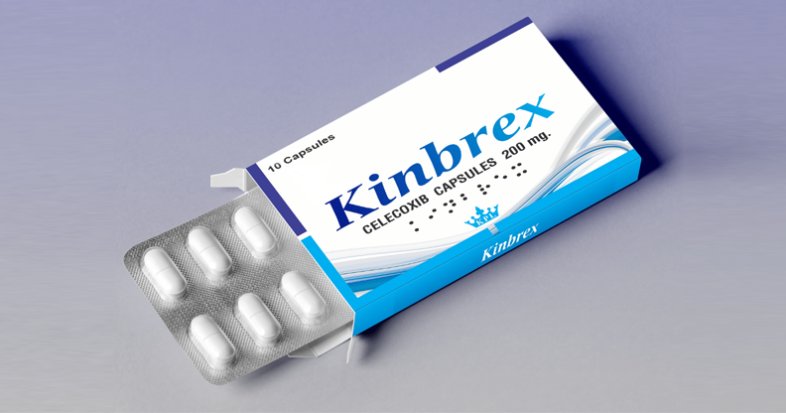KINBREX CAPSULES

PHARMACOLOGICAL ACTION
Pharmacodynamic properties
Celecoxib is a specific cyclooxygenase-2 inhibitor (SCI). Cyclooxygenase-2 (COX-2) is induced in response to inflammatory stimuli. This leads to the synthesis and accumulation of inflammatory prostanoids, in particular prostaglandin E2, causing inflammation, oedema and pain. Celecoxib acts as an anti-inflammatory, analgesic and anti-pyretic agent by blocking the production of inflammatory prostanoids via COX-2 inhibition.
Celecoxib is a specific cyclooxygenase-2 inhibitor (SCI). Cyclooxygenase-2 (COX-2) is induced in response to inflammatory stimuli. This leads to the synthesis and accumulation of inflammatory prostanoids, in particular prostaglandin E2, causing inflammation, oedema and pain. Celecoxib acts as an anti-inflammatory, analgesic and anti-pyretic agent by blocking the production of inflammatory prostanoids via COX-2 inhibition.
Pharmacokinetic properties
When given under fasting conditions celecoxib is absorbed reaching peak plasma concentrations after approximately 2-3 hours. Celecoxib exhibits linear and dose proportional pharmacokinetics over the therapeutic dose range. Plasma protein binding, which is concentration independent, is about 97% at therapeutic plasma concentrations and the drug is not preferentially bound to erythrocytes in the blood. Dosing with food (high fat meal) delays absorption resulting in a Tmax of about 4 hours and increases bioavailability by about 20%.
Celecoxib is metabolised in the liver by hydroxylation, oxidation and some glucuronidation and in vitro and in vivo studies indicate that metabolism is mainly by cytochrome P450 CYP2C9. Pharmacological activity resides in the parent drug. The main metabolites found in the circulation have no detectable COX-1 or COX-2 inhibitory activity.
Elimination of celecoxib is mostly by hepatic metabolism with less than 1 % of the dose excreted unchanged in urine. After multiple dosing elimination half life is 8-12 hours and the rate of clearance is about 500ml/min. With multiple dosing steady state plasma concentrations are reached before day 5. The inter subject variability on the main pharmacokinetic parameters (AUC, Cmax, elimination half-life) is about 30%. The mean steady state volume of distribution is about 500L/70kg in young healthy adults after a single 200mg dose indicating wide distribution of celecoxib into the tissues. Pre-clinical studies indicate that the drug crosses the blood/brain barrier.
When given under fasting conditions celecoxib is absorbed reaching peak plasma concentrations after approximately 2-3 hours. Celecoxib exhibits linear and dose proportional pharmacokinetics over the therapeutic dose range. Plasma protein binding, which is concentration independent, is about 97% at therapeutic plasma concentrations and the drug is not preferentially bound to erythrocytes in the blood. Dosing with food (high fat meal) delays absorption resulting in a Tmax of about 4 hours and increases bioavailability by about 20%.
Celecoxib is metabolised in the liver by hydroxylation, oxidation and some glucuronidation and in vitro and in vivo studies indicate that metabolism is mainly by cytochrome P450 CYP2C9. Pharmacological activity resides in the parent drug. The main metabolites found in the circulation have no detectable COX-1 or COX-2 inhibitory activity.
Elimination of celecoxib is mostly by hepatic metabolism with less than 1 % of the dose excreted unchanged in urine. After multiple dosing elimination half life is 8-12 hours and the rate of clearance is about 500ml/min. With multiple dosing steady state plasma concentrations are reached before day 5. The inter subject variability on the main pharmacokinetic parameters (AUC, Cmax, elimination half-life) is about 30%. The mean steady state volume of distribution is about 500L/70kg in young healthy adults after a single 200mg dose indicating wide distribution of celecoxib into the tissues. Pre-clinical studies indicate that the drug crosses the blood/brain barrier.
INDICATIONS
- Symptomatic treatment of inflammation and pain in osteoarthritis and rheumatoid arthritis.
- Treatment of pain post dental surgery.
CONTRA-INDICATIONS
- Hypersensitivity to any ingredient of the product; known sulphonamide hypersensitivity.
- Severe impairment of hepatic function.
- Severe impairment of renal function.
- Asthma, urticaria or allergic-type reactions precipitated by aspirin or non-steroidal anti-inflammatory agents.
- Pregnancy and lactation, as safety has not been demonstrated.
DOSAGE AND DIRECTIONS FOR USE
Osteoarthritis and Rheumatoid arthritis :
The recommended daily dose is 200-400 mg taken in two divided doses. 200 mg once a day can also be used in osteoarthritis.
Pain post dental surgery :
The recommended dose is 100 mg to 200 mg up to a maximum daily dose of 400 mg. Dosing intervals should not be less than 4 hours.
The recommended daily dose is 200-400 mg taken in two divided doses. 200 mg once a day can also be used in osteoarthritis.
Pain post dental surgery :
The recommended dose is 100 mg to 200 mg up to a maximum daily dose of 400 mg. Dosing intervals should not be less than 4 hours.
SIDE-EFFECTS AND SPECIAL PRECAUTIONS
Side-Effects :
Adverse events reported in controlled clinical trials:
Central Nervous System : Headache, dizziness
Gastrointestinal : Constipation, nausea, abdominal pain, diarrhoea, dyspepsia, flatulence, vomiting. Serious clinically significant upper gastro-intestinal bleeding has been observed in patients receiving CELECOXIB, although infrequently.
Respiratory : Bronchitis, coughing, pharyngitis, rhinitis, sinusitis, upper respiratory tract infection
Other : Arthralgia, back pain, insomnia, myalgia, pain, peripheral pain, pruritus, tooth disorder, accidental injury, allergy aggravated, ‘flu-like symptoms, peripheral oedema, rash, urinary tract infection
Adverse events reported in controlled clinical trials:
Central Nervous System : Headache, dizziness
Gastrointestinal : Constipation, nausea, abdominal pain, diarrhoea, dyspepsia, flatulence, vomiting. Serious clinically significant upper gastro-intestinal bleeding has been observed in patients receiving CELECOXIB, although infrequently.
Respiratory : Bronchitis, coughing, pharyngitis, rhinitis, sinusitis, upper respiratory tract infection
Other : Arthralgia, back pain, insomnia, myalgia, pain, peripheral pain, pruritus, tooth disorder, accidental injury, allergy aggravated, ‘flu-like symptoms, peripheral oedema, rash, urinary tract infection
Known Symptoms Of Overdosage And Particulars Of Its Treatment :
There is no clinical experience of overdose. Single doses up to 1200mg and multiple doses up to 600mg twice daily have been administered to healthy subjects without clinically significant adverse effects. In the event of suspected overdose, appropriate supportive medical care should be provided. Dialysis is unlikely to be an efficient method of drug removal.
There is no clinical experience of overdose. Single doses up to 1200mg and multiple doses up to 600mg twice daily have been administered to healthy subjects without clinically significant adverse effects. In the event of suspected overdose, appropriate supportive medical care should be provided. Dialysis is unlikely to be an efficient method of drug removal.
STORAGE INSTRUCTIONS
- Keep in a cool place protected from light. Keep out of reach of children.
PRESENTATION
- Blister Pack of 10 x 10 Capsules (100 capsules) in a mono pack & 10 such packs in a Box.

